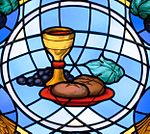| Part of a series on the |
| Eucharist |
|---|
 |
The Lima Liturgy is a Christian ecumenical Eucharistic liturgy. It was written for the 1982 Plenary Session of the Faith and Order Commission of the World Council of Churches (WCC) in Lima, Peru and reflects the theological convergences of the meeting's Baptism, Eucharist and Ministry (BEM) document as expressed in liturgy. The liturgy was used again at the closing of a 1982 meeting of the Central Committee of the WCC in Geneva, Switzerland, in 1983 during the Sixth Assembly of the WCC in Vancouver, Canada, in 1991 at the Seventh Assembly of the WCC in Canberra, Australia, and, albeit unofficially, in 1993 at the fifth world conference on Faith and Order in Santiago de Compostela, Spain. Although the Eucharist has not been celebrated at WCC Assemblies after 1991 using the Lima or any other liturgy, the Lima Liturgy has been used in ecumenical events all over the world. For instance, many churches in North America use it on World Communion Sunday.
Another goal of the liturgy is to allow as many Christians as possible to take part in a joint celebration of the Eucharist. Due to church discipline, members of some traditions, such as the Catholic and Eastern Orthodox churches, are not allowed to receive the Eucharist when the Lima Liturgy is celebrated. The liturgy has received both praise and criticism. The Orthodox, in particular, have criticized the liturgy for not being able to resolve the issue of ecclesiology and the Eucharist. For example, one female Oriental Orthodox member of the Central Committee of the WCC was discredited by her church for having taken part in the celebration of the Lima Liturgy as reader and was ultimately forced to resign.